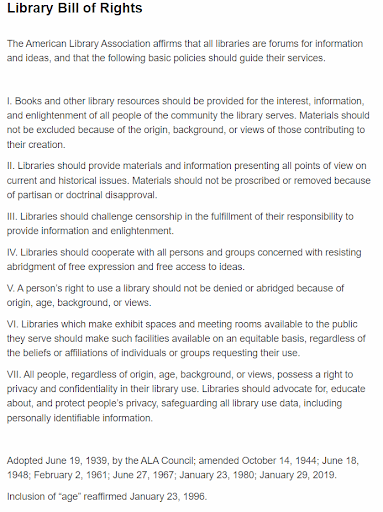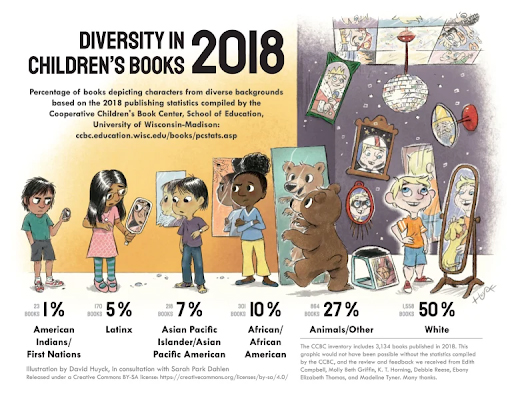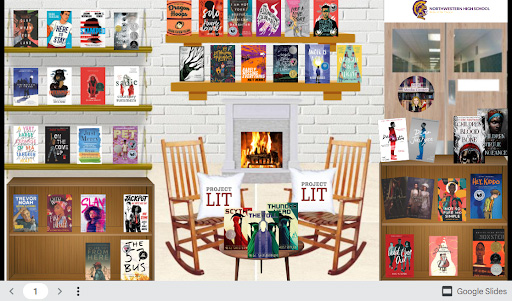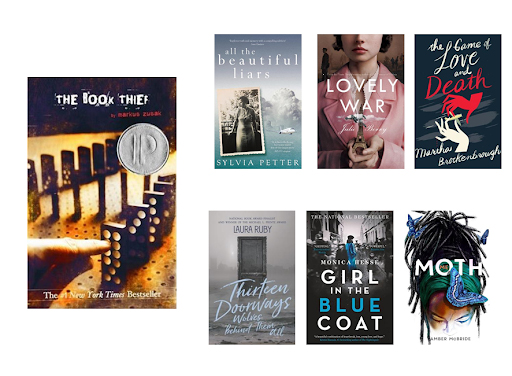Much has been written about the importance of classroom libraries at all grade levels. But how many research studies make the connection between classroom and school libraries?
Classroom teachers should never feel overwhelmed with the responsibility of providing a rich, vibrant, diverse classroom library when there is a school librarian in the building who fulfills that role. In addition, a student in one class should not have better access to books than a student in another class simply because one teacher may have more money to spend on a classroom library.
Particularly in these challenging times due to seemingly relentless censorship efforts from organizations, legislators, and parents, classroom teachers should know they are not alone! School librarians are ready to share their professional knowledge of intellectual freedom to ensure classroom libraries are built upon students’ rights to read, which will withstand the storm of current controversies.
Did You Know?
- Libraries rely on core ethics and principles based on the First Amendment and the freedom to read.
- Libraries do not personally or institutionally endorse every idea contained within or made available through its service.
- Libraries follow selection, acquisition, and reconsideration policies.
- Librarians know how to organize materials to ensure maximum access and representation.
- The classroom library and school library, although serving different purposes, should complement each other.
What Classroom Teachers Should Know about Intellectual Freedom
Refresh your knowledge of intellectual freedom:
- Unfettered access to information and ideas
- The right to seek and to receive information without restriction
Intellectual freedom is the essence of equitable library services (AASL). Students have the right to seek and to receive information at school in the form of books and other instructional materials. Libraries are even more unique within a school because, as the Supreme Court held in Island Trees School District vs. Pico in 1982, they are places of “voluntary inquiry.” Students have the right to explore personal interests and topics at school. Of course, schools implement common sense limitations for school collections and minors; however, personal systems of beliefs are not acceptable guidelines for determining which information to make available to all students in the school.
Read and display the American Library Association’s Library Bill of Rights:

All people regardless of age have the right to access information. Additionally, minors do not develop at the same rates, making arbitrary designations like “developmentally appropriate” not an ideal one-size-fits-all approach to building library collections. In a free society, reading materials should not be prejudged in order to prevent access.
Another guiding document is the American Association of School Librarians’ Diversity in Collection Development. Classroom teachers should know that “failure to select resources merely because they may be potentially controversial is censorship, as is withdrawing resources for the same reason.” Similarly, one family’s objection should not limit all students’ access to the same information.
Diversity is not limited to race. School librarians consider a variety of important elements of a diverse book collection when making selections:
- Socio-economic status
- Race, ethnicity, religion
- Sexual and gender identity
- Global perspectives
- Historical perspectives
- Accessibility
Steps for Classroom Teachers Building Classroom Libraries:
- Ask your school librarian for the school’s selection and reconsideration policies. Work with them to write something similar to guide classroom library development, ensuring equity and diversity.
- Know your students. Their needs and interests should guide your selections. Teachers naturally build this knowledge through everyday conversations, curriculum work, and attending students’ extracurricular events.
- Differentiate needs for your classroom library versus the school library because a classroom is not meant to be the same type of educational space as the school library (and most classroom teachers cannot afford to build a classroom library to rival the school library).
- Just say no to restricted reading sections! A separate section stigmatizes those books and marks them as controversial, as it will stigmatize the students who want to read them. Often, arbitrary criteria are used to restrict access to these books, infringing on students’ rights to information. For example, placing a book with an LGBTQ+ character in a restricted section would constitute an infringement.
- Take care with any book labels you consider using. Just as you would not label a book as heterosexual, do not label books as LGBTQ+. Doing so creates an “other” distinction that can create negative stigmas for both the reader and the book. Using the label “mature content” is also an arbitrary designation because each student has a different maturity level.
- Ask your librarian how to organize books for appeal, ease of access, and equity. Do not organize books by reading levels. Doing so creates stigmas surrounding reading abilities, forces students to reveal their test scores to others, and may prevent students from selecting reading materials of their choice.
- Do not physically alter books added to your classroom library. Using a black marker to eliminate “controversial” wording or passages or covering up images censors an artist’s work and forces arbitrary value systems.
- Take stock of what you already have. Librarians often embark on a diversity audit to assess their collections and determine which areas are lacking representation in respect to their students and communities. For example, if your student population is 60% Hispanic but only 5% of your book collection features Hispanic characters, there is an imbalance that can be corrected.
- The diversity audit also calls attention to the artist or author. If the information is available, determine if authors and artists of diverse backgrounds and experiences are represented in the collection. Particularly relevant to historically marginalized groups, find book reviews that evaluate how these groups are represented in books. For example, does a book about Asians contain any outdated stereotypes (e.g., Asian characters are all smart or look the same)? Consider the role of a minority character in a book. From the HijabiLibrarians blog, “how many of your books feature Muslims as background or side characters as opposed to protagonists?” As Crisp notes, “it is fundamentally important that those shaping the creation and dissemination of children’s books have the knowledge and cultural intuition needed when working with texts, as it makes it less likely that children’s books with problematic, inaccurate, and dishonest treatments continue to make their way into classrooms and the hands of young readers.” (Note: #OwnVoices is no longer being used by We Need Diverse Books. Authors and artists should never be pressured to share sensitive personal information, which could be used against them.)
- Learn how librarians use professional journals to access book reviews, award lists, and more. Websites like Goodreads and Common Sense Media can provide secondary guidance, but they operate privately and are not based on the ethics of the library profession.
Concerned about Censorship?
In the new censorship battles, pro-censors have hijacked the term “equity,” equating it with Marxism and attempts to make all students the same. In education, equity means that all students have opportunities to access information despite any disabilities or handicaps. Reading levels, topics, languages, text size, and audio are all considerations to take into account to ensure equity of access.
Pro-censors might argue that there is no need for diversity efforts, and that these efforts further divide students. However, research proves that false. According to research by the Cooperative Children’s Book Center, in a review of children’s books published in 2018, more children’s books featured animals as characters than all minority groups combined. The organization has since separated Latinx and Pacific Islander into separate categories and added Arab as a category.

Publisher Lee & Low released research showing a lack of diversity within the publishing industry as well (an overwhelming majority of those working in the mainstream publishing industry are white, cisgender, able-bodied, and straight). Librarians can encourage classroom teachers to consider adding books from smaller or local publishers to ensure a wider range of views.
Classroom Teacher—School Librarian Collaboration
No money for a classroom library? Get creative! One positive result of the pandemic was the proliferation of ideas and technology to create virtual libraries. Utilizing a hyperlinked Google Slide, a virtual library is a visually appealing and practical way to integrate parts of the school library into the classroom. Consider this example from Tenley Middleton, school librarian at Nation Ford High School in South Carolina.

Instead of an individual classroom teacher selecting, purchasing, and organizing these titles, the school librarian can use images of the book covers to provide links to the books available in the school library collection or to websites for students to learn more about them. Utilize this approach for book talks and read alouds.
When Russia invaded Ukraine in February 2022, I used this idea to make a virtual library incorporating articles from Infobase databases to encourage students to extend their learning.

When I was a classroom teacher, I asked the school librarians to send me a cart of books related to our unit of study. This cart stayed in my classroom during the unit so I could encourage students to browse the selections when there was downtime. I did this while my students were reading Upton Sinclair’s The Jungle and also when we were studying rhetoric and argument in the Civil Rights Movement. Your librarian can provide fiction and nonfiction materials to match a variety of reading levels, including articles and graphic novels.
Classroom teachers can also create units of study based on school library materials. I implemented a banned books project for several years before becoming a school librarian. I had a cart of books that had been challenged or banned throughout history as well as nonfiction books about book censorship and free speech rights. As an alternative to a whole-class read, each student chose a book to read and to research.
Now, when I hear students enjoying a particular book that has been assigned in an English class, I make a read-alike list after acquiring similar titles to encourage further reading and exploration.

Overall, keep in mind that education is not indoctrination; simply hearing an idea does not mean that someone is forcing you to adopt it as your own belief. Parents and their children select appropriate reading materials, but classroom teachers and school librarians ensure that open access (in terms of content and accessibility) applies to all students.
Resources for Book Selection and Anti-censorship tools
American Indians in Children’s Literature, Dr. Debbie Reese of Nambé Pueblo and Dr. Jean Mendoza
Association for Library Services to Children (ALSC), Book and Media Awards
Banned in the USA, most recent report from PEN America
Defending Intellectual Freedom: LGBTQ+ Materials in School Libraries, resource guide from AASL
Freedom to Read Statement, American Library Association
Get Ready Stay Ready, a community action toolkit for parents and caregivers sponsored by librarian professionals
Hijabi librarians, blog providing guidance for developing diverse collections with Muslim representation
Research on Diversity in Youth Literature, an open-access, peer-reviewed journal hosted by St. Catherine University’s Master of Library and Information Science Program and University Library
We Need Diverse Books, “non-profit that advocates essential changes in the publishing industry to produce and promote literature that reflects and honors the lives of all young people”
Young Adult Library Services Association, Book awards and booklists
See also:
- Webinar: Becoming the K–12 Embedded Librarian: Encouraging Librarians to Collaborate to Foster Relationships within Their Schools
- Preparing for Book Challenges
- Defending Intellectual Freedom with Educational Opportunities
References:
Crisp, Thomas, et al. “What’s on Our Bookshelves? The Diversity of Children’s Literature in Early Childhood Classroom Libraries.” Journal of Children’s Literature, vol. 42, no. 2, Fall 2016, pp. 29–42. EBSCOhost.
Huyck, David and Sarah Park Dahlen. (2019 June 19). Diversity in Children’s Books 2018. sarahpark.com blog. Created in consultation with Edith Campbell, Molly Beth Griffin, K. T. Horning, Debbie Reese, Ebony Elizabeth Thomas, and Madeline Tyner, with statistics compiled by the Cooperative Children’s Book Center, School of Education, University of Wisconsin-Madison: https://ccbc.education.wisc.edu/literature-resources/ccbc-diversity-statistics/books-by-about-poc-fnn/. Retrieved from https://readingspark.wordpress.com/2019/06/19/picture-this-diversity-in-childrens-books-2018-infographic/.
Marcoux, Elizabeth “Betty” and David V. Loertscher. “The Role of a School Library in a School’s Reading Program.” Teacher Librarian, vol. 36, no. 1. Oct 2009. pp. 8-14.
Williams, Jenelle and Kortlandt, Megan (2021) “Big Kids Need Books Too: Lessons Learned From Building Classroom Libraries at the Secondary Level,” Michigan Reading Journal: Vol. 53 : Iss. 2 , Article 11. Available at: https://scholarworks.gvsu.edu/mrj/vol53/iss2/11.
Zepp, Lauren B. “Building Classroom Libraries for High School Students with Disabilities.” WSRA Journal, vol. 57, no. 2, Summer 2020. pp. 25-34, https://www.researchgate.net/profile/Lauren-Zepp/publication/344254362_Building_classroom_libraries_for_high_school_students_with_disabilities/links/5fe3577745851553a0e492eb/Building-classroom-libraries-for-high-school-students-with-disabilities.pdf, Accessed 9 December 2022.


